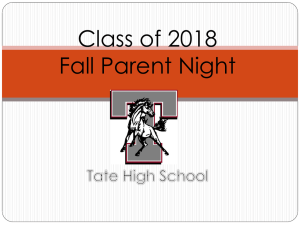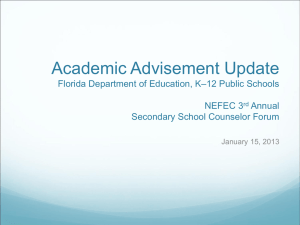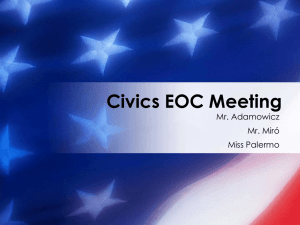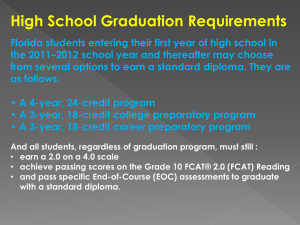DOE_K_12 - State University System of Florida
advertisement
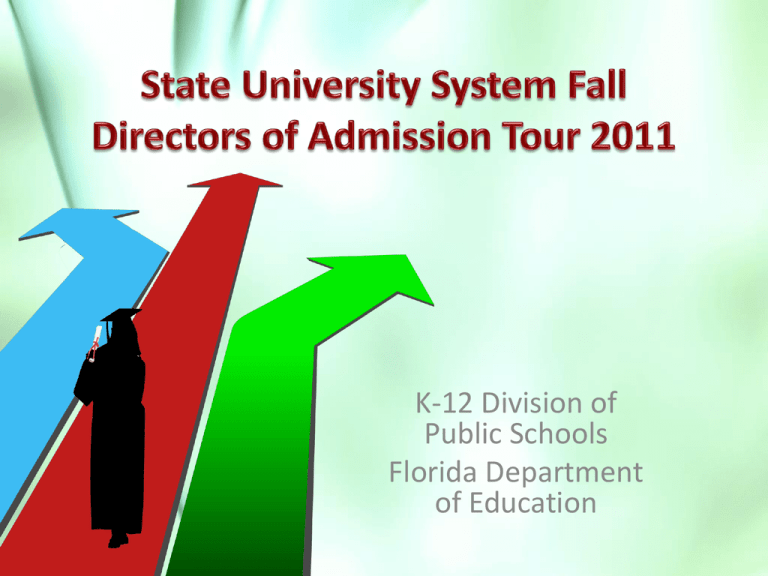
K-12 Division of Public Schools Florida Department of Education • • • • • • • SUS Standard Admissions College and Career Readiness High School Graduation Requirements Middle Grades Progression Students with Disabilities FACTS.org Resources • High school diploma – public or regionally accredited high school, or its equivalent – Home education program – Non-traditional high school program • Grade Point Average (GPA) in high school academic core courses – Weighted GPA will be calculated by the university • Additional weights may be assigned to certain courses • GPA in High School Academic Core Courses Summer 2011 or later applicants – High school GPA of 3.0 or higher on a 4.0 scale as calculated by the university (still must take the SAT or combined ACT with writing) OR – High school GPA or 2.5 -2.99 on a 4.0 scale as calculated by the university. Minimum test scores required are: • SAT-Critical Reading ≥ 460 or ACT – Reading ≥ 19 • SAT-Mathematics ≥ 460 or ACT – Mathematics ≥ 19 • SAT-Writing ≥ 440 or ACT Combined English with Writing ≥ 18 • English • Mathematics 4 Credits 4 Credits (algebra I and higher) • Natural Science • Social Science • Foreign Language 3 Credits 3 Credits 2 Credits (sequential courses in the same language) • SUS Approved Electives 2 Credits Total 18 Credits (Be sure to double-check to see if courses are SUS approved) • Grade 12 Students in 2011-2012 – 4 mathematics units at the Algebra 1 level and higher – Algebra 1a and 1b sequence will satisfy two credits – Applied Math 1 and Applied Math 2 sequence will satisfy two credits • Liberal Arts Math counts as one of the four required credits of Algebra 1 or higher as long as the course was taken in 2008-2009 or 2009-2010 • Grade 11 Students in 2011-2012 and classes following: – 4 mathematics units at the Algebra 1 level and higher • Algebra 1a and 1b sequence will satisfy one credit • Applied Math 1 and Applied Math 2 sequence will satisfy one credit • Liberal Arts Math will not count as one of the four credits for SUS admission Summer 2011 or Later Applicants • Students may demonstrate two-year proficiency for purposes of SUS admissions and the Bright Futures Scholarship Program with completion of: – Second course in high school (such as Spanish 2 or French 2) or first course via AP, IB, or AICE. – Second postsecondary course (foreign language (a foreign language Elementary 2) as long as the course is 4.0 semester credits OR – Third postsecondary course (a foreign language Intermediate 1, regardless of credits. www.FACTS.org 2011-2012 Edition Students are considered college and career ready when they have the knowledge, skills, and academic preparation needed to enroll and succeed in introductory college creditbearing courses within an associate or baccalaureate degree program without the need for remediation. http://www.fldoe.org/cc/collegecareerreadiness.asp • College readiness evaluation is required for students who score – Grade 10 FCAT 2.0 Reading (Levels 2 or 3) – Grade 10 FCAT Mathematics (Levels 2, 3, or 4) • Applies to students who entered grade nine in 2009-2010 (current juniors) • Postsecondary Education Readiness Test (P.E.R.T.) or its equivalent State Board Education Rule 6A-10.0315, F.A.C. • Purpose: to prepare students for entry into college level credit courses as well as gainful employment • High schools are required to offer postsecondary preparatory instruction • Students must complete postsecondary preparatory instruction prior to graduation • Students who complete the College Success courses and/or English IV: Florida College Prep will be required to take the P.E.R.T. for future placement purposes at a Florida College System institution • Aligns with the current practice for Mathematics for College Readiness Available online at the Florida Department of Education’s Graduation Requirement’s page http://www.fldoe.org/BII/Stud entPro/grad-require.asp Entering 9th Grade 2010 2011 2012 2013 To Graduate Algebra and Geometry + Biology and Algebra EOC + Biology EOC, Geometry EOC and Algebra II + Chemistry or Physics and an equally rigorous science course • Algebra 1 or a series of equivalent courses or higher – 1 credit – Algebra 1 End-of-Course (EOC) Assessment • Must pass in order to earn course credit • If student enters with course credit student is exempt from the Algebra 1 EOC Assessment • Geometry or a series of equivalent courses credit – 1 credit – Must take the Geometry EOC Assessment and results must be included as 30% of the student’s course grade – If student enters with course credit, the student is exempt from the Geometry EOC Assessment requirement • Biology 1 or a series of equivalent courses – 1 credit – Must take the Biology 1 EOC Assessment and results must be included as 30% of the student’s course grade – If student enters with course credit, the student is exempt from the Biology 1 EOC Assessment requirement • Online Learning – 24-credit graduation option – Earn at least one course through online learning • The requirement is met – Through an online course offered by » The Florida Virtual School » The high school or » A district interinstitutional articulation agreement dual enrollment course – A high school course taken online in grades 6 through 8 – A student who is enrolled in a full-time or part-time virtual instruction program See District VIP Q and A at http://www.fldoe.org/Schools/virtual-schools/ • Applies to a middle and high school student who scores at Level 1 or Level 2 on the FCAT Reading but who did not score below Level 3 the previous three years • One year exemption only • Student must have an academic improvement plan (AIP) in place • Each district school board shall provide each student (six through 12) and their parents with information on three- and fouryear options • Selection may be completed by the student at any time during grades nine through 12 – Required written consent of the student’s parent unless student is 18 years old Effective for the 2011-2012 school year: • The school district shall permit a student who is not enrolled in or has not completed the related course to take the standardized EOC during the regular administrations of the EOC. Code Definition/Example A The student took and passed the EOC assessment required for the course. B The student took and failed the EOC assessment required for the course. C The student did not yet take the EOC assessment required for the course. D The transfer student is exempt from taking the EOC assessment required for the course. E The student took and passed the EOC assessment required for the course and consequently exempted all or part of the course. F The student with a disability had the EOC assessment requirement for this course waived. Z The course does not have a required EOC assessment or the student is not in a cohort that requires the taking of the EOC assessment. Current Code New Code MA A1 SC BI Code Definition Algebra 1 or equivalent OR any postsecondary course with a number of MAT 1033 or MAC course completed through dual enrollment Biology or equivalent OR any postsecondary course in the BSC prefix or PCB prefix course in Genetics completed through dual enrollment For incoming 9th grade students in 2011-2012 • Algebra 1 • A student completing Algebra 1 or its equivalent must take the assessment and achieve a passing score in order to be awarded high school credit. • Geometry and Biology 1 – A student completing this course or an equivalent must take the EOC • No state requirements to calculate in results into final course grade or to be awarded high school credit – If the credit is earned through a passing grade in the course, the student does not need to retake or pass the EOC assessment upon entering high school. • 2012-2013 entering 6th graders are must successfully complete at least a onesemester civics education course • Civics EOC Assessment – 2012-2013 field test – 2013-2014 results will constitute 30 percent of the student’s final course grade – 2014-2015 a student must earn a passing score in order to pass the course and meet middle grades promotion requirements Critical Skills for Students with Disabilities Transitioning into Postsecondary Education or Training – Self-Awareness of Disability – Accommodation Needs – Self-Advocacy – Differences between Secondary and Postsecondary • Accommodations for SAT/ACT • Documentation of disability for accessing accommodations • Test waivers • Agency supports Academic planning tools and resources for Florida’s middle, high school and college students. Updated for Professionals Available in 3 languages Can assist Dual Enrollment students Student Bookmarks Student Pocket Guides Available from the Counselors & Educators tab OnSite, OnLine or OnDemand for 2011-2012 • OnSite District & Regional Trainings • OnLine Weekly Webinars & District Webinars • OnDemand Recorded Webinars Click on any event for information and/or registration Locate calendar from Counselors & Educators tab Contact: hlancash@usf.edu Or Helen.Lancashire@fldoe.org (850) 245-7851

